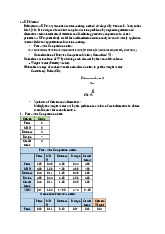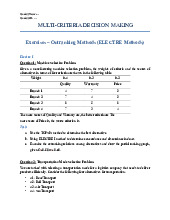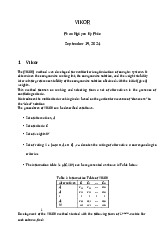




Preview text:
Student Name:… Student ID: …
MULTI-CRITERIA DECISION MAKING
Exercises – Outranking Methods (ELECTRE Methods) Electre I
Question 1: Machine Selection Problem
Given a manufacturing machine selection problem, the weights of criteria and the scores of
alternatives in terms of four criteria are shown in the following table: Weight 0.4 0.3 0.2 Quality Warranty Price Branch 1 4 7 2 Branch 2 7 4 2 Branch 3 8 5 8 Branch 4 7 3 4
The more scores of Quality and Warranty are, the better criteria are The
more score of Price is, the worse criterion is. Task:
a. Use the TOPSIS method to determine the best alternative.
b. Using ELECTRE I method to determine concordance and discordance indexes
c. Examine the outranking relations among alternatives and draw the partial ranking graph,
given C¿=0.60,D¿=0.50.
Question 2: Transportation Mode Selection Problem
You are tasked with selecting a transportation mode for a logistics company that needs to deliver
products efficiently. Consider the following four alternatives for transportation: • A1: Road Transport • A2: Rail Transport • A3: Air Transport • A4: Sea Transport 1 Student Name:… Student ID: …
Evaluate the alternatives based on the following criteria:
1. Cost (C1): Lower cost is better.
2. Delivery Time (C2): Shorter time is better.
3. Environmental Impact (C3): Lower impact is better.
4. Reliability (C4): Higher reliability is better.
The decision matrix below shows the performance of each alternative against the criteria: Cost (C1) Delivery Time (C2) Environmental Reliability (C4) ($/unit) Impact (C3) (on-time percentage) (days)
(CO emissions, tons₂ ) A1: Road 50 4 2.0 85% A2: Rail 40 7 1.5 90% A3: Air 100 5 3.5 95% A4: Sea 30 10 1.2 80%
The weights for each criterion are provided below: • Cost (C1): 0.35 •
Delivery Time (C2): 0.25 •
Environmental Impact (C3): 0.2 • Reliability (C4): 0.2
Additionally, the following thresholds are provided for the ELECTRE I method: •
Concordance threshold (C¿): 0.55 •
Discordance threshold (D¿): 0.35 Task:
Using the ELECTRE I method, follow the steps below to determine the best transportation mode for the logistics company:
1. Normalize the decision matrix.
2. Weight the normalized decision matrix using the provided criterion weights.
3. Compute the concordance and discordance matrices.
4. Identify the dominance relationships among the alternatives.
5. Determine the outranking relations and eliminate any dominated alternatives.
6. Rank the alternatives based on your ELECTRE I results.
Question 3: Distribution Center Selection Problem
A global company is evaluating the best location to establish a new distribution center. The
decision requires analyzing four alternatives based on a set of important criteria. The company has
identified four potential locations: 2 Student Name:… Student ID: … • A1: New York, USA • A2: Rotterdam, Netherlands • A3: Shanghai, China • A4: São Paulo, Brazil
You have been provided the following key decision criteria for evaluating these alternatives: •
C1: Transportation Cost (minimize) •
C2: Delivery Time to Key Markets (minimize) •
C3: Political Stability (maximize) •
C4: Infrastructure Quality (maximize)
Performance of Alternatives
The alternatives have been assessed against the criteria as shown in the following table: C1: Transportation C2: Delivery C3: Political C4: Infrastructure Cost Time Stability Quality ($/unit) (days) (Rating: 1-10) (Rating: 1-10) A1: New York 75 4 8 9 A2: Rotterdam 55 6 9 8 A3: Shanghai 60 9 5 7 A4: São Paulo 45 11 6 6 Criteria Weights
The company’s strategic priorities have been reflected in the following weights assigned to each criterion: •
Transportation Cost (C1): 35% • Delivery Time (C2): 25% •
Political Stability (C3): 20% •
Infrastructure Quality (C4): 20%
Additionally, the following thresholds are provided for the ELECTRE I method: •
Concordance threshold (C¿): 0.65 •
Discordance threshold (D¿): 0.35 Task:
Using the ELECTRE I method to identify the best location for the distribution hub. Question 4:
Suppose a multi – attribute decision problem for mounting a global positioning system (GPS) is
considered. Four alternatives are considered according to four criteria: reliability, functionality,
service, and accuracy. The corresponding preferred ratings of each alternative can be defined by a 3 Student Name:… Student ID: …
five-point ordinal scale: 1 – Very Dissatisfied (VD), 2 – Dissatisfied (D), 3 – Unsatisfied (U), 4 –
Satisfied (S), and 5 – Very Satisfied (VS), as shown in table below
Table: Decision table for GPS problem
Alternative Reliability Functionalit Service Accuracy s y #1 U D S VS #2 D VS D S #3 D VD S D #4 U VS U S Weights 0,35 0,15 0,2 0,3
Use ELECTRE I to obtain the best alternative. Show the table of value of Concordance Index,
Discordance Index and Outranking graph for the GPS problem (setting C¿ = 0.7 and D¿ = 0.7) Electre II Question 5:
Use ELECTRE II to determine the full ranking of alternatives based on Strong outranking (SF)/
Weak outranking (Sf ) relationships presented in the following table: Alternatives A1 A2 A3 A4 A5 A6 A7 A1 - SF SF A2 Sf - SF SF Sf A3 - Sf SF A4 - Sf SF A5 - A6 SF - A7 - Question 6:
Use ELECTRE II to determine the full ranking of alternatives based on Strong outranking (SF)/
Weak outranking (Sf ) relationships presented in the following table: Alternatives A1 A2 A3 A4 A5 A1 - SF SF 4 Student Name:… Student ID: … A2 SF - SF SF SF A3 - Sf A4 - A5 Sf SF - Question 7:
Suppose a decision-making problem for purchasing a notebook is considered. In order to choose
one of the four alternatives, four criteria, quality, price, function, and service, are considered. The
preferred ratings, with respect to each alternative, and the weight, with respect to each criterion,
are given as shown in the table below.
Table: Preferred Ratings of Each alternative for Notebook purchasing problem Preferred Ratings Quality Price Function Service Alternative #1 4 2 6 8 Alternative #2 8 9 1 4 Alternative #3 8 2 3 1 Alternative #4 1 2 3 1 Weights 0,2 0,2 0,3 0,3
Use ELECTRE II to obtain the best alternative. Show the table of value of Concordance Index,
Discordance Index, the Descending and Ascending orders for the problem
(Set C+¿=0.7;C−¿=0.6;D ¿
+¿=0.5; D−¿=0.7¿¿ ¿) 5




